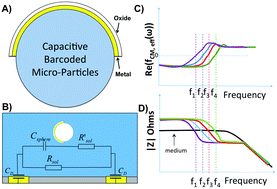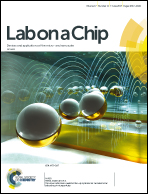Top-down fabrication meets bottom-up synthesis for nanoelectronic barcoding of microparticles
Abstract
Traditional optical and plasmonic techniques for barcoding of micro-particles for multiplexed bioassays are generally high in throughput, however bulky instrumentation is often required for performing readout. Electrical impedance based detection allows for ultra-compact instrumentation footprint necessary for wearable devices, however to date, the lack of ability to electronically barcode micro-particles has been a long standing bottleneck towards enabling multiplexed electronic biomarker assays. Nanoelectronic barcoding, which to the best of our knowledge is the first impedance based solution for micro-particle barcoding, works by forming tunable nano-capacitors on the surface of micro-spheres, effectively modulating the frequency dependent dielectric properties of the spheres allowing one bead barcode to be distinguished from another. Nanoelectronic barcoding uses a well-known, but unexplored electromagnetic phenomenon of micro-particles: the Clausius–Mossotti (CM) factor spectrum of a Janus particle (JP) shifts depending on the zeta (wall) potential of the metallic half of the microsphere, and the fact that the complex impedance spectrum of a particle directly corresponds to the CM factor spectrum. A one-to-one correspondence will be established between each biomarker and the corresponding engineered microsphere. This transformative new method for barcoding will enable a new class of handheld and wearable biosensors capable of multiplexed continuous temporal bio-monitoring. The proposed nano-electronically barcoded particles utilize both bottom-up synthesis and top-down fabrication to enable precisely engineered frequency dependent dielectric signatures. Multi-frequency lock-in measurements of the complex impedance, in conjunction with multi-variate analysis of impedance data, allows for particle differentiation using a fully functional ultra-compact electronic detector.



 Please wait while we load your content...
Please wait while we load your content...